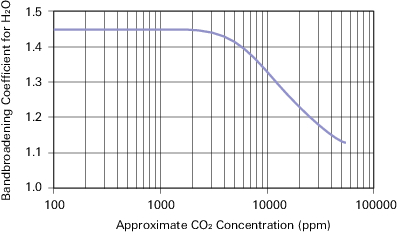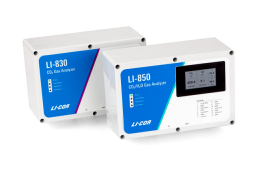Equation Summary
The LI-830 and LI-850 compute CO2 concentrations using an equation of the form
A‑1
where c is concentration, f() is the calibration function, a" is the absorptance, g (a,P) is the pressure correction, S(a) is the span, and T is the temperature (°C) of the gas in the cell, typically 51.5 °C. Absorptance is computed from
A‑2
a' is a span corrected absorptance, and g(a,P) is the pressure correction.
A‑3
S(a) is the span function, and raw absorptance a is computed from
A‑4
where V and Vo are the raw detector sample and reference readings, and Z is the zeroing parameter.
Span is a linear function of absorptance.
A‑5
H2O Equations (LI-850 only)
Absorptance aw for water vapor is computed from
A‑6
where Vw and Vwo are the sample and reference raw detector readings, and Zw is the zero parameter. The pressure correction for water vapor is an empirical function gw() of absorptance and pressure P:
A‑7
The value of Po is 99 kPa. When the pressure correction is not enabled, gw() is simply 1.0. Water vapor concentration W (mmol mol-1) is computed from
A‑8
where fw(x) is a third order polynomial whose coefficients are given on the calibration sheet.
A‑9
CO2 Equations
The measurement of CO2 is a bit more complicated than for H2O because of the influence of water vapor. There is a slight direct cross sensitivity in the CO2 signal to H2O. This is measured at the factory and accounted for in the computation of absorptance (equation A‑10). There is also a band broadening effect that is accounted for in the computation of concentration (equation A‑14).
CO2 absorptance ac is computed from
where Vc and Vco are the raw detector signals for sample and reference, Zc is the CO2 zero parameter, and Xwc is a cross sensitivity parameter for the effect of water vapor on CO2. Its value is reported on the calibration sheet as XS=.
The empirical pressure correction function gc() depends on CO2 absorptance and pressure:
When P = Po, gc() = 1.
When P < Po
where a = 1.10158, b = -6.1217E-3, c = -0.266278, d = 3.69895, and z is the asymptotic value of absorptance, obtained from the calibration coefficients (equation A‑15).
When P > Po
A‑13
where X, A, and B are computed as in equation A‑11. CO2 concentration C (µmol mol-1) is computed from
where fc(x) is a function whose inverse is a double rectangular hyperbola, and whose coefficients (a1…a4) are given on the calibration sheet.
Solving equation A‑15 for C yields the calibration function
A‑16
Where
A‑17
ψ(W) accounts for band broadening by water vapor.
A‑18
The band broadening coefficient h(ac) has been determined to be 1.45 for the instrument for CO2 concentrations near ambient. At higher concentrations, the value decreases. We capture this behavior with an empirical relationship (equation A‑19).
Where z is from equation A‑12, and bw is the low concentration band broadening coefficient: 1.45. This is the value shown on the calibration sheet as BB = 1.45. The typical relationship between h(ac) and CO2 concentration is shown in Figure A‑1. (‘Typical’ because the exact relationship depends on the relationship between absorptance and CO2, which is the calibration curve.)

Note: We formulated equation A‑19 with 0.64bw – 0.64 instead of the simple equivalent (0.29) because this allows band broadening corrections to be turned off by setting bw to 1. When bw =1, h(ac) = 1 everywhere. Also, to avoid computational problems (underflows, overflows, and division by zero) we constrain the argument ac when computing h(ac) to be 0.1 < ac ≤ z. ac - 0.1 is typically equivalent to about 600 ppm.
Calibration Equations
The following equations describe the implementation of zero and span calibrations.
Zeroing H2O (LI-850 only)
When the command for zeroing water is received, the LI-850 computes the water zero from equation A‑20, where and
are averaged for 5 seconds.
Zeroing CO2
When the command for zeroing CO2 is received, the instrument computes the CO2 zero term from equation A‑21, where ,
,
, and
are averaged for 5 seconds.
Spanning H2O (LI-850 only)
When the command for setting the span for H2O is received, along with the target concentration WT, from the target concentration, the target absoprtance aT is computed from
A‑22
LI-850 computes Sw0 from equation A‑23 , where is averaged over five seconds.
where
The instrument retains the following values, which are used for subsequent secondary spans:
A‑25
Secondary Span H2O (LI-850 only)
When the secondary span command for H2O is received, the instrument computes new values for both Sw0 and Sw1. First, it measures a new and computes a new
from equation A‑24. Then, it uses these plus the retained values (
and
from the previous normal span) to compute
A‑26
Given the new span slope Sw1, it updates the span offset Sw0 by equation A‑23.
Spanning CO2
When the command for setting the CO2 span is received, along with the target concentration CT, the instrument computes Sc0 from equation A‑28, where and
are averaged for 5 seconds.
A‑27
where
Note that
We need acT to compute , but acT depends on
. We resolve this by using an approximation (equation A‑31) instead when computing equation A‑30
The instrument retains the following values, which are used for subsequent secondary spans, if necessary:
A‑32
A‑33
Secondary Span CO2
When the secondary span command for CO2 is received, the instrument computes new values for both Sc0 and Sc1. First, it measures a new and computes a new βc from equation A‑29. Then it uses these, plus the retained values (ac1 and βc1 from the previous normal span) to compute
A‑34
Given the new span slope Sc1, it updates the span offset Sc0 by equation A‑28.
